More and more people are turning to swimming ponds instead of traditional pools – and we completely understand why. There’s something truly refreshing about dipping into clean, chemical-free water surrounded by plants and wildlife. It’s a brilliant way to cool off and make the most of your garden during the warmer months.
If you’ve ever wondered, ‘Can you swim in a pond?’ The short answer is ‘yes’, if it’s designed for it. Whether you’re just curious or planning to create your own swim pond, you’re in the right place.
We’ll guide you through the essentials, from safety and water clarity to what’s involved in turning a regular pond into one you can actually swim in. Let’s jump in and explore what’s possible.
Understanding Ponds and Natural Swimming
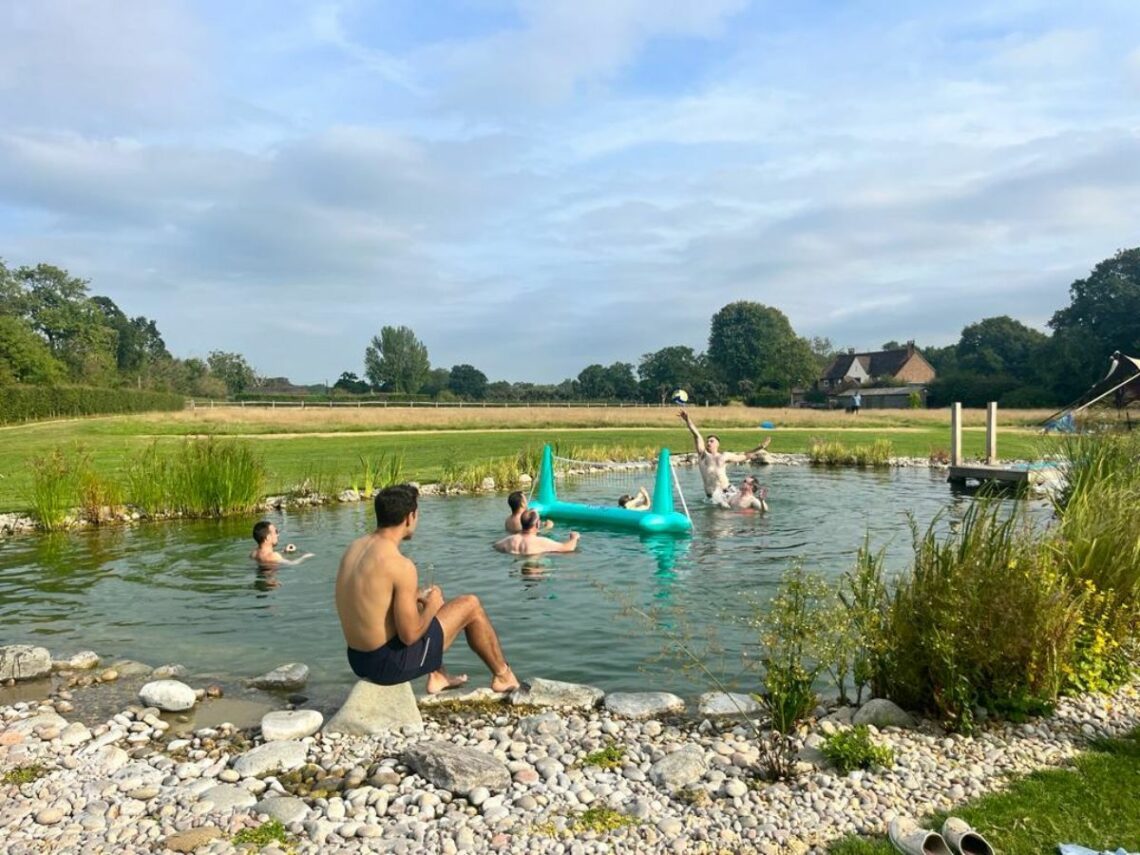
Swimming in natural water is a completely different experience from a traditional pool. It’s calmer, cleaner, and a lot more in tune with the outdoors. You’re surrounded by plants, birds, and the quiet of your own garden – no harsh chlorine smells, just proper fresh water.
What is a Swimming Pond?
A swimming pond is designed for both looks and function. It might look like a normal garden pond at first glance, but it’s built for swimming, and it’s far more eco-friendly than a typical pool.
At Ponds by Michael Wheat, we specialise in creating beautiful, bespoke swimming ponds. You get all the benefits of wild swimming but with the safety and clear water that comes from good design. Our unique Michael Wheat System uses layered filtration and plant zones to keep water clean, naturally without chlorine.
Instead of chlorine, we use a clever mix of natural filtration and planting to keep the water clean. This setup:
- Removes impurities without using harsh chemicals
- Encourages more wildlife into your garden
- Helps create a space that feels natural and relaxing to swim in
So, can you swim in a pond?
Yes! You can, as long as the pond is built for it and looked after properly.
Not every pond is safe to swim in. The water needs to be tested and clear, and the pond should be designed with swimming in mind. That means safe entry points, no sharp, submerged rocks or sunken trees under the surface, and the right depth for a comfortable swim.
It’s also important to manage things like animal waste, which can contribute to harmful bacteria like faecal coliform bacteria and E. coli bacteria types that affect water safety and quality. A well-designed swim pond takes care of all of that, so you can enjoy your garden without worrying about what’s in the water.
With the right setup, your pond can be a great place to relax, recharge, and enjoy nature all year round.
The Reality of Natural Swimming: 4 Things to Expect
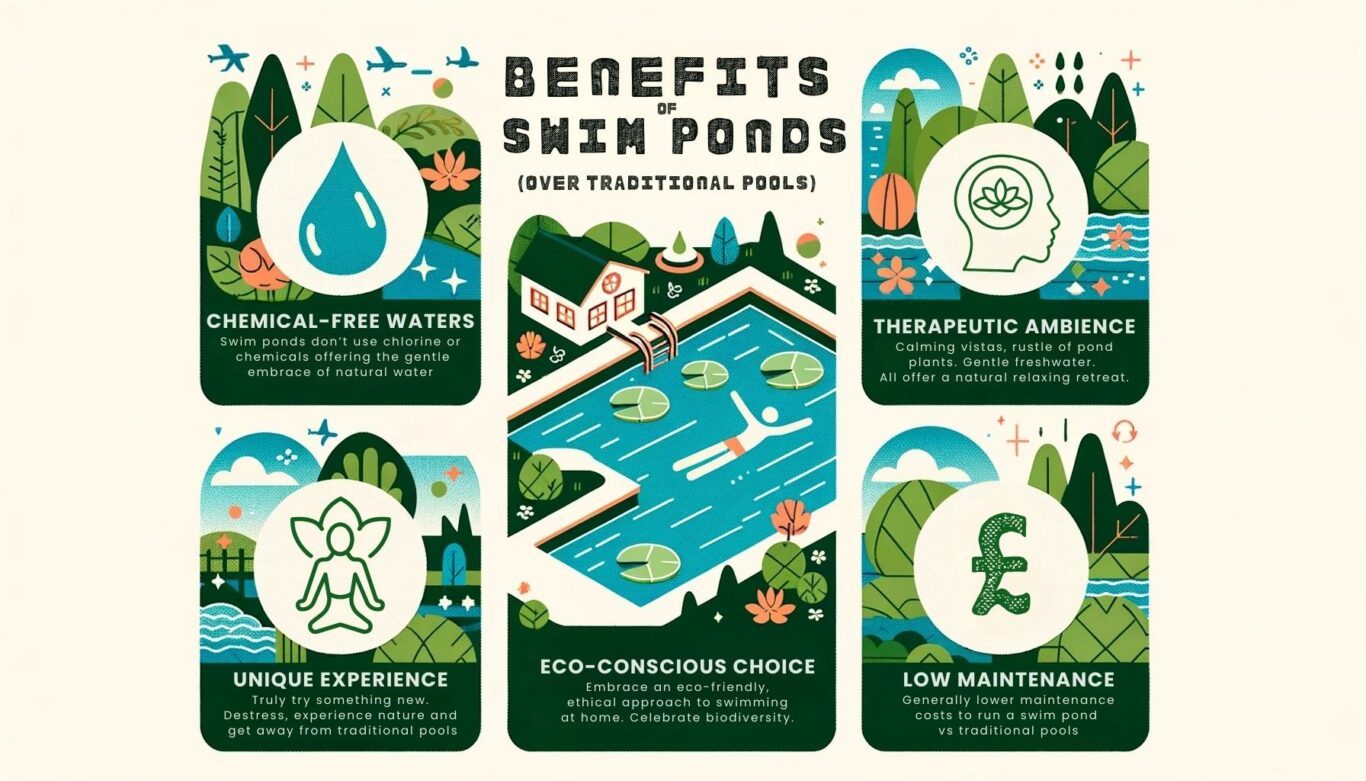
Swimming in a natural pond is a brilliant experience, but it’s good to know what comes with it. It’s not like a tiled pool with bright blue water and chemicals. It’s a living, breathing space that changes with the seasons and works alongside nature.
That’s part of the charm. But if you’re new to the idea, here’s what to expect.
1. It’s Not a Pool (And That’s a Good Thing)
Swimming ponds, also known as natural swimming pools, don’t use chlorine or harsh chemicals. Instead, they rely on clever design and natural filtration to keep the water clear.
That means you’ll be swimming in water that’s full of life – from microorganisms to aquatic plants and, depending on your setup, maybe even a few visiting frogs or dragonflies.
It’s a bit like wild swimming, but in a space designed to be safe, clean, and part of your garden.
2. Water Quality is Carefully Managed
Even without chlorine, swimming pond water can be safe and crystal clear thanks to a proper biological filtration system and the right plants. These work together to remove nutrients and keep the water balanced, helping prevent unwanted algae and bacteria from taking over.
We take this seriously at Ponds by Michael Wheat; every pond we build is designed to stay clean and healthy with the right maintenance.
3. You Might Share the Water with Wildlife
You’re likely to see some pond plants growing at the edges or even underwater. And depending on your design, you might share your swim with a few harmless pond visitors. That’s all part of being closer to nature, and many of our clients say it’s one of their favourite parts of the experience.
4. Expect Seasonal Changes
Unlike a regular pool, a natural pond shifts with the seasons. You might see more algae in summer, leaves falling in autumn, and the surface icing over in winter. These changes are completely normal, and we offer pond maintenance packages to help manage each season properly, from pond water testing to routine cleaning.
How to Make Your Pond Safe for Swimming
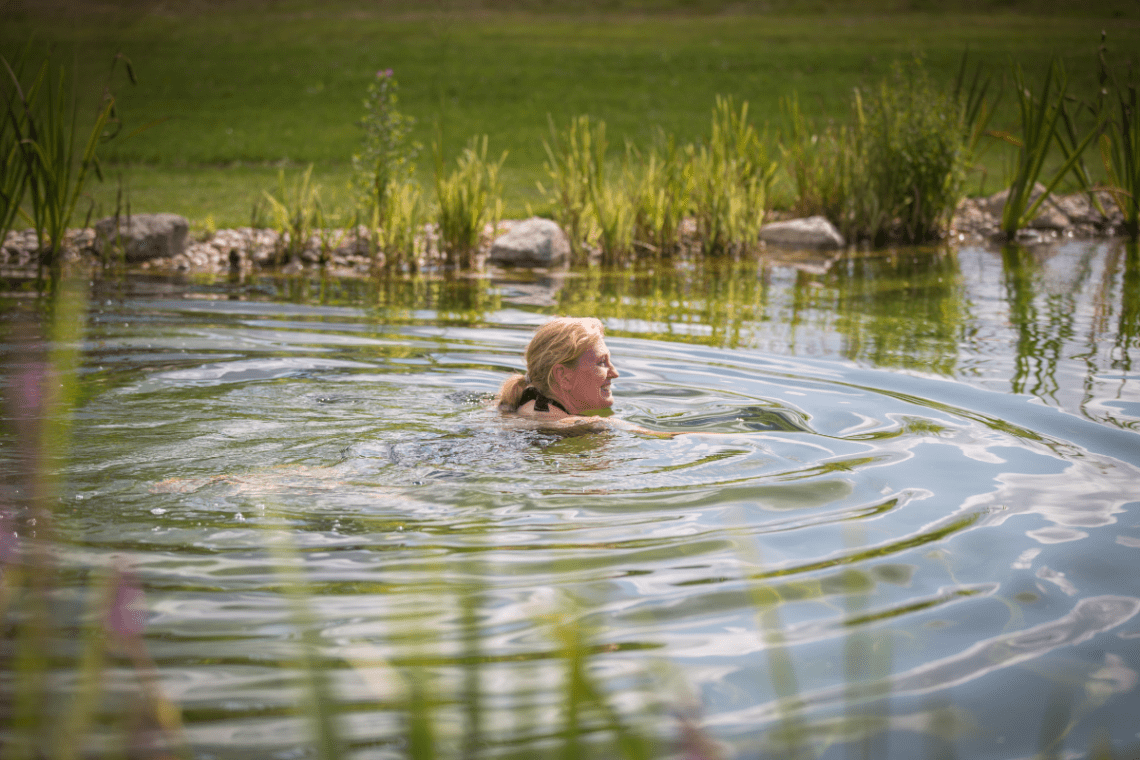
If you’re thinking about swimming in your pond, it’s important to get the design right from the start with a swimming pond company that has pond design experts. Safety isn’t just something we add on at the end – it’s built into every decision we make during the design and build process.
At Ponds by Michael Wheat, we specialise in creating beautiful, safe swim ponds using clever design and natural filtration systems. Whether you’re starting fresh or want to convert your existing pond into a swimming pond, we’ll help you make it safe, functional, and enjoyable.
What Makes a Swimming Pond Safe?
Here are the key elements that make a swimming pond safe:
- Water Quality: Crystal-clear water starts with proper filtration. Our natural systems use pumps and aquatic plants to keep the water fresh, moving, and clean – no chlorine needed.
- Depth: A steady, predictable depth helps avoid sudden drops, which is especially important if children or nervous swimmers are using the pond.
- Entry and Exit Points: Safe and accessible entry and exit points, such as gently sloped beaches or sturdy steps, provide comfort and reduce the risk of slips or falls.
- Rocks and Debris: Yes, natural pools may contain stones – but that’s exactly why design matters. A professionally built swimming pond includes a well-prepared, clean pond floor, so there are no nasty surprises underfoot.
Every pond is unique – and so is our approach. Whether we’re building from scratch or converting an existing pond, the goal is the same: safe, natural swimming you’ll love for years to come.
Algae in Summer
It’s true that algae can bloom in warmer months. But in a properly filtered swimming pond, this is less of an issue. Professional systems use clever natural filtration like UV filtration and aquatic plants to keep the water clean, clear, and safe to swim in year-round.
Blanket weed is a common concern, especially in the warmer months. To control it, many pond owners rely on effective solutions like Blanketweed Gone to keep growth in check naturally.
Still curious about safety and how it all works? Check out our full guide: Are Swimming Ponds SAFE to Swim In?
Final Thoughts
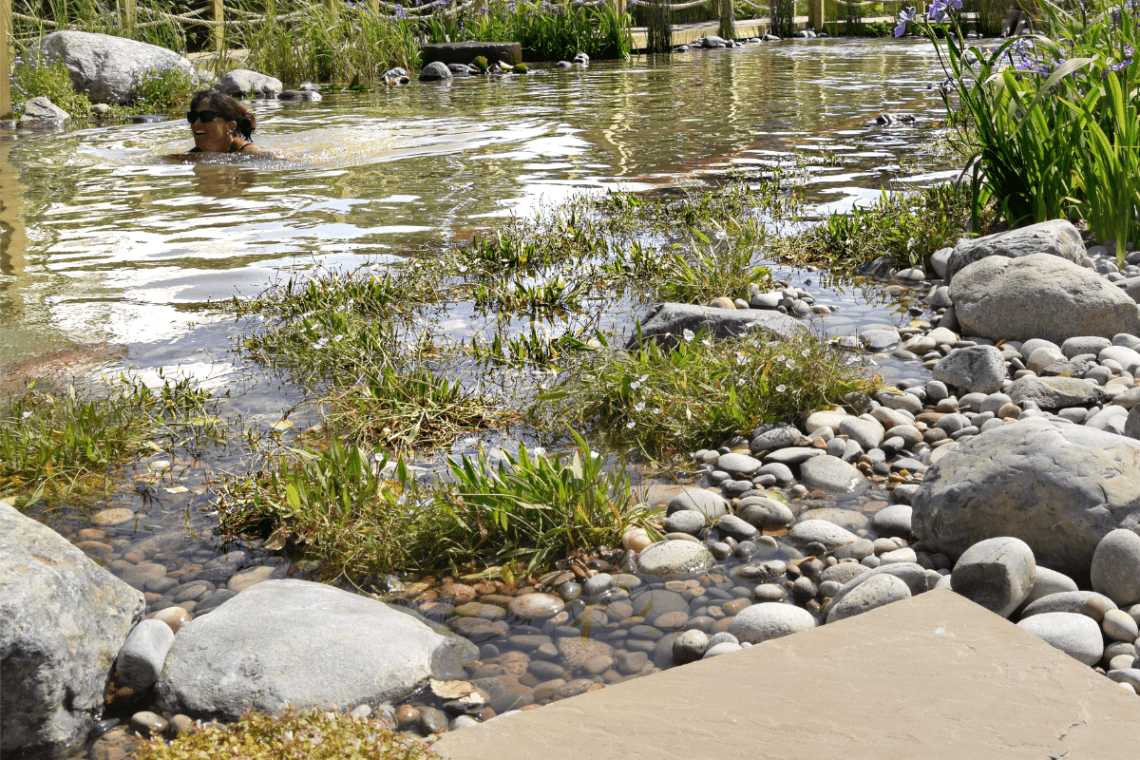
Swimming in a swim pond isn’t just possible – it’s one of the most rewarding ways to enjoy the water. With the right design, filtration, and a bit of planning, a swimming pond becomes a beautiful, low-maintenance alternative to traditional pools.
You get crystal-clear, chemical-free water, the gentle presence of nature, and a space that feels good for both you and the environment.
Thinking of making the switch?
Get in touch with the team at Ponds by Michael Wheat or download our free Pond Inspiration Guide – we’ve designed and built hundreds of stunning swimming ponds – and we’d love to help you create yours.
Whether you’re just curious or ready to dive in, we’re here to help you every step of the way.
Frequently Asked Questions
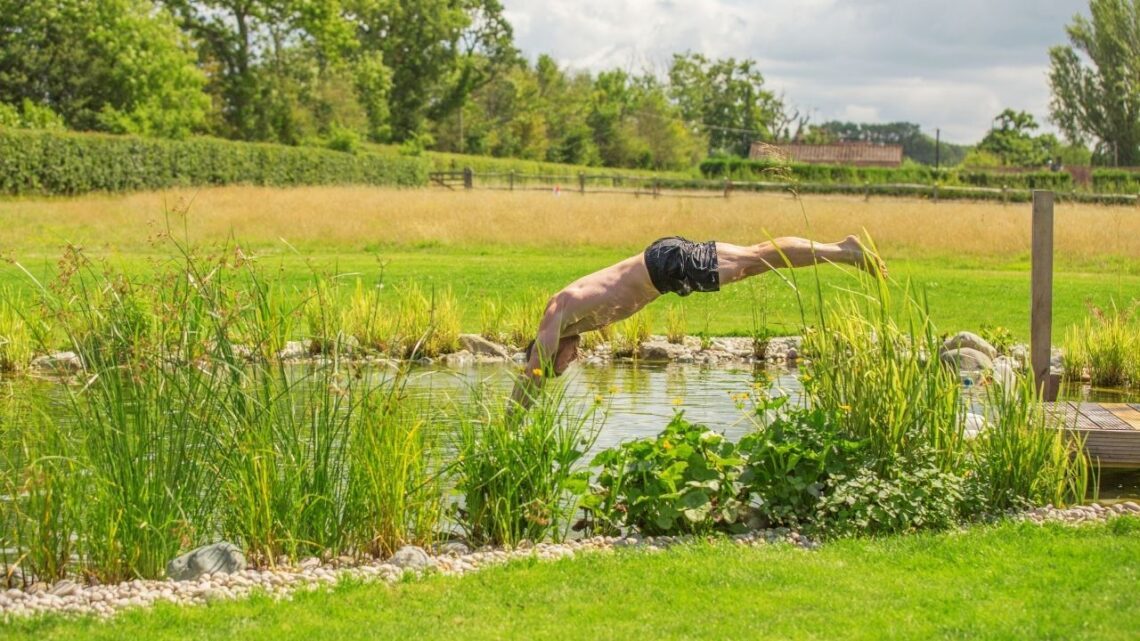
1. Can you swim in any pond, or does it have to be specially designed?
Not every pond is safe to jump into. Water that hasn’t been filtered correctly can contain blue-green algae, human waste, or other contaminants that make the water unsafe.
You should regularly have the water tested and ensure it’s clear and circulating – not stagnant water. Ponds that collect runoff or are near septic systems may even contain traces of human sewage, which significantly raises health risks.
Swimming in untreated water carries risks, especially when the pond wasn’t built for it. That’s why we always say: swim at your own risk if the pond hasn’t been assessed or professionally designed for swimming.
2. What kind of plants are used in swimming ponds?
Most swimming ponds include a mix of marginal plants, floating plants, and submerged oxygenators, all chosen to work together as part of a layered filtration system. Acting as natural filters, pond plants absorb excess nutrients from the water, reducing the likelihood of algae in swimming ponds.
They also support a healthy pond ecosystem by:
- Providing habitat for beneficial microorganisms that help break down organic matter.
- Balancing nutrients in the water, preventing imbalances that lead to murkiness or algae growth through a natural filtration system that uses pond plants.
- Enhancing aesthetics, giving your pond a tranquil, natural look that’s as pleasing to the eye as it is refreshing to swim in.
3. What maintenance do ponds need?
Regular checks, cleaning, and some seasonal care keep your pond in good shape. Plants and filters need a little attention, but swimming ponds in particular are generally low-maintenance compared to traditional pools.
4. Can swimming ponds be used all year round?
Yes, though natural changes like algae growth in summer or leaves in autumn are normal. With good maintenance, your pond can be enjoyed in every season.